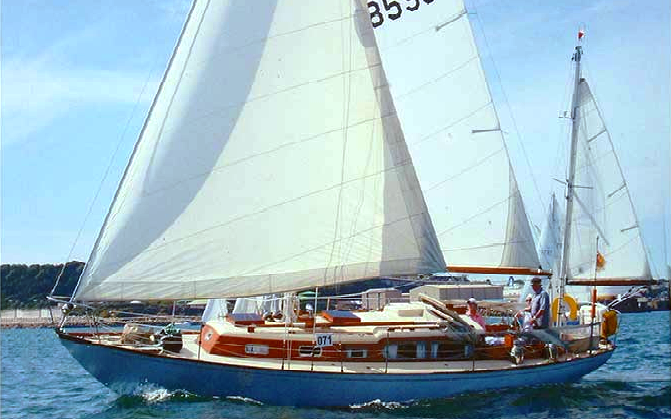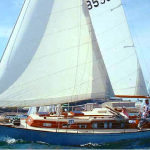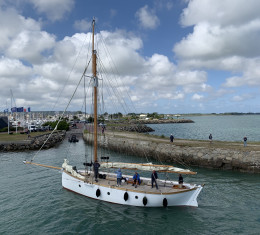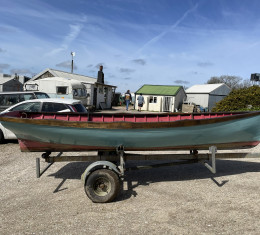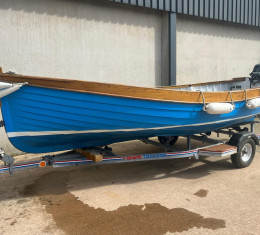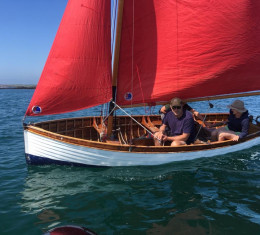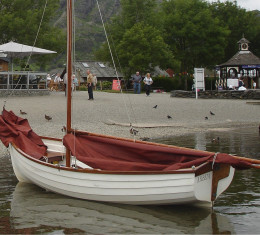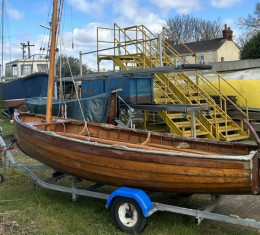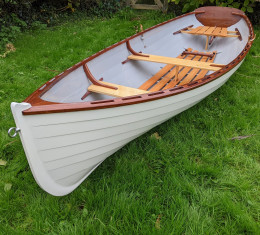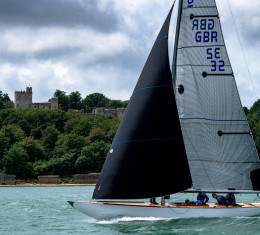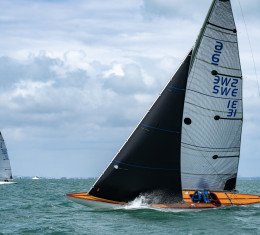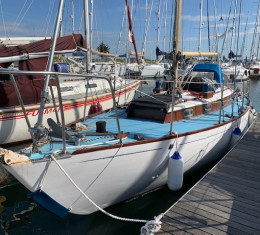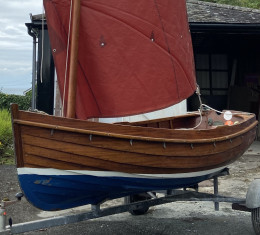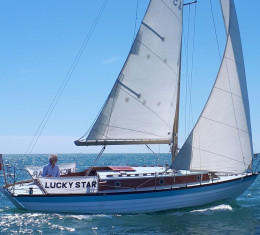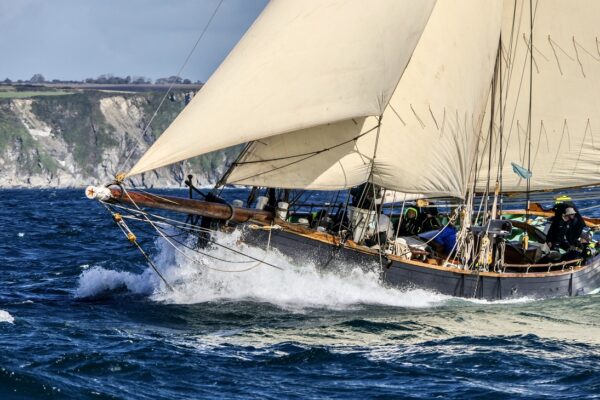Sailing yachts
Full specification
Wooden ships comments on this John Alden Challenger Centreboard Yawl
The challenger yawl was one of the last designs drawn by John Alden himself before his death in 1962, and is very similar to the S&S designed Finisterre. The offices of Alden and Stephens had spent many years competing against each other on the racing circuit, but a co-operation between the two great designers during WWII brought their designs closer together.
The American navy employed Stephens and Alden to carry out in depth research into hull design by employing state of the art tank testing techniques. The result of this was that they gained an enormous wealth of knowledge in the field of hydrodynamics and employed this in their post war yacht designs.
Halmatic of Portsmouth saw the business potential of the Challenger design and started moulding the hulls in fibreglass which was the newest and most up to date construction material of the day. As was typical of many early GRP boats, the lay up was enormously thick as the material had not been proved with time, so to ensure the strength the builders made the hulls incredibly thick. Several boats were built to this design using conventional timber construction techniques, but the lure of the modern GRP meant Halmatic found a healthy market for these yachts in the USA. Yachting World remarked in 1960 that there were obvious benefits for the owner in having a GRP hull, and although it was not common at the time, they stated it would not be long before we caught up with the Americans and GRP yachts of Class III RORC and larger would be commonplace in UK waters. This of course was very true, and within 10 years it would be hard to find a yard building wooden yachts on a commercial basis.
Built in 1960, this yacht had a major refit in 2002 by the previous owner in which the hull was stripped below the water line, dried using the Hotvac system, and had 5 layers of glass cloth applied then finished with an epoxy coating.
Hull constructed of heavy GRP layup with fibreglass frames and stringers. Steel frames in way of the main mast to stiffen the hull in the high stress areas. Frames in the saloon and forepeak reinforced in 2002.
The underwater area was filled and finished with epoxy and given 2 coats of Coppercoat which is still proving effective barrier to fouling.
The topsides were sanded back and sprayed using a Hempels 2-pack paint.
External lead keel bolted through the hull with bronze bolts. 350lb bronze centreplate drops through the lead ballast keel, operated using a simple screw mechanism to a stainless steel braided wire. The centreplate was removed in 2002, the enormous bronze pivot pin was replaced along with the stainless wire. The mechanism is easily operated with a handle on the forward bulkhead of the cockpit.
Decks are constructed of a single layer of GRP. This means it is not a sandwich type construction which can have problems with water ingress and saturation. Deck is finished in 2 pack deck paint.
Coachroof coamings made of solid teak and mounted onto the GRP deck carlings. Toughened glass windows with stainless steel bezels along the coamings. The coachroof deck was replaced in 2011 with marine plywood sheathed in epoxy cloth.
Cockpit constructed in solid teak with plenty of space for the crew. Thwarts and cockpit sole finished in straight laid teak planking with thwarts all round and a bridge deck to the companionway. Port and starboard thwarts lift to give access to deep cockpit lockers.
Wheel steering on a new stainless steel pedestal with a repeater screen for the Raymarine plotter mounted in front of the wheel. Cables to steering quadrant and teak rudder, rebuilt 2013 with new bronze internal bolts. Unlike some boats, there is still plenty of space to move fore and aft around the wheel without disturbing the helm.
Watertight hatch in the sole gives access to the stern gland.
The generous beam which was an emerging feature of American yacht design at the time allows for wide side decks for easy movement around the boat. Large foredeck with centre mounted Lofrans electric windlass.
Twin roller stainless steel stem head fitting incorporating fairleads and attachment for the forestay.
Stainless pulpit with port and starboard navigation lights.
Forehatch at the forward end of the coachroof with varnished teak handrails either side.
Hatch just aft of the mast over the main saloon. Small step in the coachroof up to the doghouse. Companionway with sliding hatch and garage offset to starboard with spray hood mounted on the raised coachroof. A pair of chromed dorade vents mounted on varnished teak boxes in way of the main mast. Spinnaker pole mounts on the coachroof
Deep hardwood toe rail all round with stainless steel stanchions mounted slightly inboard so as to avoid dirt building up between the stanchion base and toe rail. This is only possible because of the very wide side decks, still allowing plenty of space to move around.
Aft deck with a self draining gas locker recessed in. Large mooring cleats, bronze fairleads and a bronze dorade vent to allow ventilation into the lazarette.
Mizzen is deck stepped just inside the aft cockpit coaming with the short mainsheet traveller forrard of this. Still allows room for the helmsman to move around the wheel and to be within easy reach of the mainsheet which is useful when short handed.
Rig
Bermudan yawl rig on 1987 white painted alloy masts.
Main mast is keel stepped with a reinforcing steel shoe to spread the load. Roller reefing varnished spruce main boom with a stainless steel roller mechanism on the goose neck.
Deck stepped alloy mizzen mast with varnished wooden boom and stainless gooseneck.
Captive wire Lewmar halyard winches on both main and mizzen.
Stainless steel standing rigging all new in 2003 to internal stainless steel chainplates.
Mainmast has a jumper strut, single lowers, intermediate stay, single cap shroud and an unusual swept back cap shroud running just aft of the spreaders. Single standing backstay
Mizzen has single lowers, single cap shroud and a similar swept back cap shroud to the main mast.
Roller furling headsail on ProFurl furling system installed in 2007.
All running and standing rigging was replaced in 2003.
Winches
Pair of large Lewmar 2 speed primary sheet winches mounted on stainless steel brackets on the side deck and fastened through the cockpit coamings
Pair of top action spinnaker winches at the aft end of the cockpit.
Lewmar captive wire halyard winches on each mast
2 Lewmar single speed winches on the mainmast.
Sails
Mainsail Good condition
Mizzen Good condition
Genoa Good condition
Storm trysail Good condition
Storm jib Good condition
Mizzen staysail Good condition
No.2 genoa Tired
No.3 genoa Tired
Spinnaker Serviceable
Cruising chute with snuffer (2007) As New
Machinery
Yanmar 40hp 3 cyl marine diesel installed new in 2002. Yanmar gearbox with stainless steel shaft to 3 blade Featherstream propeller fitted in 2007.
Engine beds cut out and completely rebuilt to take the new engine. Propellor, shaft, and stern gear all new in 2002.
Stainless steel 40 gallon diesel tank under the settee berth. Stainless tank below the cabin sole in the bilge with a total of 70 gallons that is currently not in use but could be utilised for fuel if longer voyages were anticipated.
Dedicated 105ah engine start battery.
2 x 180ah domestic batteries charged from the engine alternator with an Adverc battery management system to optimise charging time.
All pipe work and seacocks replaced in 2002. Seacocks are now Marelon
Accommodation 6 berths
Companionway is offset to starboard in the cockpit with steps down into the saloon. This was a clever trick which maximises space for the galley while still allowing for a usefully sized chart area on the opposite side.
L-shaped galley to port with the cooker on the outboard side and the large work surface stretching over half the beam of the boat to the aft against the bulkhead. This means the galley does not encroach into the saloon and is another benefit of the offset companion steps.
2 burner gas stove with grill and oven. Plenty of storage behind the galley with dedicated lockers for crockery. Deep top access chest fridge, requires new compressor. Single stainless sink with hand pumped fresh water from 40 gallon stainless tank under starboard settee berth.
Chart desk to starboard with standing room to work at the desk. Electronics under the deckhead with lockers behind.
Spacious saloon with full standing headroom. Drop leaf table on the centreline with inlaid varnish sole boards. Port and starboard settee berths with full length very wide pilot berths both sides.
Plenty of stowage under pilot berths. Solid fuel stove at forward end of saloon to port with original tiled surround. Hanging lockers and storage port and starboard at forward end of saloon.
Heads compartment to port at forward end of saloon with Jabsco sea toilet and hand basin.
Forepeak with twin V-berths under the forehatch and storage under. Anchor locker forward with space to stow extra fenders and warps.
Interior joinery was refurbished in 2002 with most brightwork being sanded and revarnished with new upholstery and curtains.
The interior of this yacht is very spacious for a yacht of this period as the American designers had realised the hydrodynamic benefits of increased beam. At first this was purely a performance feature but they quickly realised it meant there were benefits for the owner with increased interior volume. 2013 survey available.
Inventory
Steering compass
Raymarine GPS chartplotter/radar with repeater at the helm
B&G H1000 wind/log/depth
Icom DSC VHF
Raymarine autohelm ST6000 (2007)
VISIBALL radar reflector
Electric anchor windlass
35lb CQR
50m 3/8” chain
2 x Danforth anchors
160’ 18mm warp
Fenders
Warps
Emergency tiller
Boarding ladder
Stainless gangway
Boathook
Disclaimer:
These particulars have been prepared in good faith from information provided by the Vendors and are intended as a guide, Wooden Ships cannot guarantee or warrant the accuracy of this information nor warrant the condition of the vessel. The Purchaser should instruct his agent or surveyor to validate all details as necessary and satisfy himself with the condition of the vessel and its equipment.
Wooden Ships classic yachts brokers have an extensive database of boats for sale. With a wide range of sailboats, classic yachts, motor yachts and small classic boats, Wooden Ships has one of the largest selections of traditional wooden boats and yachts for sale in the UK.
Disclaimer:
These particulars have been prepared in good faith from information provided by the Vendors and are intended as a guide, Wooden Ships cannot guarantee or warrant the accuracy of this information nor warrant the condition of the vessel. The Purchaser should instruct his agent or surveyor to validate all details as necessary and satisfy himself with the condition of the vessel and its equipment.

